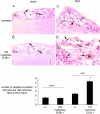Inhibition of platelet-derived growth factor promotes pericyte loss and angiogenesis in ischemic retinopathy
- PMID: 15039215
- PMCID: PMC1615330
- DOI: 10.1016/S0002-9440(10)63214-2
Inhibition of platelet-derived growth factor promotes pericyte loss and angiogenesis in ischemic retinopathy
Abstract
We investigated whether inhibition of platelet-derived growth factor (PDGF) receptor tyrosine kinase activity would affect pericyte viability, vascular endothelial growth factor (VEGF)/vascular endothelial growth factor receptor-2 (VEGFR-2) expression and angiogenesis in a model of retinopathy of prematurity (ROP). ROP was induced in Sprague Dawley rats by exposure to 80% oxygen from postnatal (P) days 0 to 11 (with 3 hours/day in room air), and then room air from P12-18 (angiogenesis period). Shams were neonatal rats in room air from P0-18. STI571, a potent inhibitor of PDGF receptor tyrosine kinase, was administered from P12-18 at 50 or 100 mg/kg/day intraperitoneal (i.p.). Electron microscopy revealed that pericytes in the inner retina of both sham and ROP rats appeared normal; however STI571 induced a selective pericyte and vascular smooth muscle degeneration. Immunolabeling for caspase-3 and alpha-smooth muscle cell actin in consecutive paraffin sections of retinas confirmed that these degenerating cells were apoptotic pericytes. In all groups, VEGF and VEGFR-2 gene expression was located in ganglion cells, the inner nuclear layer, and retinal pigment epithelium. ROP was associated with an increase in both VEGF and VEGFR-2 gene expression and blood vessel profiles in the inner retina compared to sham rats. STI571 at both doses increased VEGF and VEGFR-2 mRNA and exacerbated angiogenesis in ROP rats, and in sham rats at 100 mg/kg/day. In conclusion, PDGF is required for pericyte viability and the subsequent prevention of VEGF/VEGFR-2 overexpression and angiogenesis in ROP.
Figures





 , P < 0.005 compared to ROP + 50 mg/kg/day STI571. †, P < 0.0001 compared to ROP groups. ‡, P < 0.0001 compared to all groups.
, P < 0.005 compared to ROP + 50 mg/kg/day STI571. †, P < 0.0001 compared to ROP groups. ‡, P < 0.0001 compared to all groups.
 , P < 0.0001 compared to all groups except untreated sham. †, P < 0.0001 compared to sham groups and ROP + 100 mg/kg/day STI571. ‡, P < 0.05 compared to ROP + 50 mg/kg/day STI571. §, P < 0.001 compared to ROP + 100 mg/kg/day STI571. §§, P < 0.0001 compared to all groups.
, P < 0.0001 compared to all groups except untreated sham. †, P < 0.0001 compared to sham groups and ROP + 100 mg/kg/day STI571. ‡, P < 0.05 compared to ROP + 50 mg/kg/day STI571. §, P < 0.001 compared to ROP + 100 mg/kg/day STI571. §§, P < 0.0001 compared to all groups.References
-
- Gardner TW, Antonetti DA, Barber AJ, LaNoue KF, Levison SW. Diabetic retinopathy: more than meets the eye. Surv Ophthalmol. 2002;Suppl 2:S253–S262. - PubMed
-
- Klein R, Klein B, Moss S. Epidemiology of proliferative diabetic retinopathy. Diabetes Care. 1992;15:1875–1891. - PubMed
-
- Reynaud X, Dorey CK. Extraretinal neovascularization induced by hypoxic episodes in the neonatal rat. Invest Ophthalmol Vis Sci. 1994;35:3169–3177. - PubMed
Publication types
MeSH terms
Substances
LinkOut - more resources
Full Text Sources
Other Literature Sources
Research Materials

